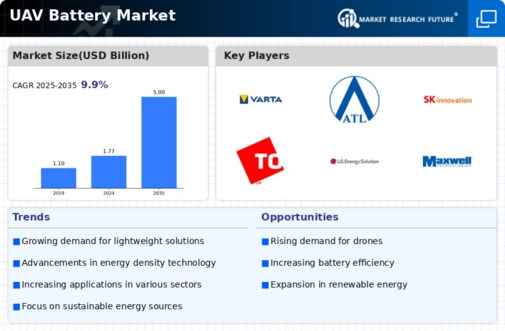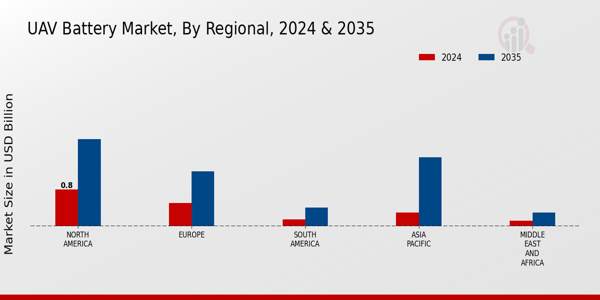Market Analysis
UAV Battery Market (Global, 2024)
Introduction
The UAV battery market is poised for significant evolution as advancements in technology and increasing applications of unmanned aerial vehicles (UAVs) continue to reshape the landscape of various industries. With the growing demand for longer flight times, enhanced energy efficiency, and lightweight solutions, battery manufacturers are focusing on innovative chemistries and designs to meet the specific needs of UAV operators. The integration of renewable energy sources and the push for sustainable practices are also influencing the development of next-generation batteries, which are expected to offer improved performance and reduced environmental impact. As the market expands, stakeholders are navigating challenges such as regulatory compliance, safety standards, and the need for robust supply chains, all of which are critical for fostering growth and ensuring the reliability of UAV operations across sectors such as agriculture, logistics, surveillance, and emergency response.
PESTLE Analysis
- Political
- In 2024, the UAV battery market is influenced by various political factors, including government regulations and policies aimed at promoting the use of drones for commercial purposes. The Federal Aviation Administration (FAA) in the United States has issued over 1,000 new drone operation permits, which has encouraged the growth of the UAV sector. Additionally, countries like China have invested approximately $2.5 billion in drone technology development, which includes advancements in battery technology, reflecting a strong political commitment to enhancing UAV capabilities.
- Economic
- The economic landscape for the UAV battery market in 2024 is shaped by rising demand for drones across various sectors, including agriculture, logistics, and surveillance. The global spending on drone technology is projected to reach $11.5 billion, with a substantial portion allocated to battery development. Furthermore, the average cost of lithium-ion batteries, which dominate the UAV battery market, has decreased by 15% over the past year, now averaging around $150 per kWh, making UAVs more economically viable for businesses.
- Social
- Social acceptance of UAV technology continues to grow in 2024, with surveys indicating that 68% of the population in urban areas support the use of drones for delivery services. This shift in public perception is driving demand for UAVs equipped with advanced battery systems. Additionally, educational initiatives and community engagement programs have increased awareness about the benefits of UAVs, leading to a 25% increase in drone pilot training enrollments compared to the previous year.
- Technological
- Technological advancements are rapidly transforming the UAV battery market in 2024. Innovations in battery chemistry, such as solid-state batteries, are being developed, promising energy densities of up to 400 Wh/kg, which is a 30% improvement over traditional lithium-ion batteries. Furthermore, the integration of artificial intelligence in battery management systems is enhancing the efficiency and lifespan of UAV batteries, with predictive algorithms reducing energy consumption by an estimated 20%.
- Legal
- The legal framework surrounding UAV operations is evolving in 2024, with new regulations being implemented to ensure safety and compliance. The European Union has introduced a new set of regulations that require all commercial UAV operators to register their drones, affecting over 200,000 operators across member states. Additionally, liability insurance requirements for UAV operators have been standardized, with minimum coverage set at €1 million, impacting the operational costs for businesses in the UAV battery market.
- Environmental
- Environmental considerations are increasingly important in the UAV battery market in 2024, with a focus on sustainability and reducing carbon footprints. The production of lithium-ion batteries generates approximately 1.5 million tons of CO2 emissions annually, prompting manufacturers to explore eco-friendly alternatives. Moreover, initiatives to recycle UAV batteries are gaining traction, with an estimated 30% of used batteries being recycled in 2024, contributing to a circular economy and reducing environmental impact.
Porter's Five Forces
- Threat of New Entrants
- Medium - The UAV battery market in 2024 presents a moderate threat of new entrants. While the market is growing due to increased demand for UAVs across various sectors, the high capital investment required for research and development, along with stringent regulatory requirements, can deter new players. Established companies benefit from economies of scale and brand loyalty, making it challenging for newcomers to gain a foothold.
- Bargaining Power of Suppliers
- Low - The bargaining power of suppliers in the UAV battery market is relatively low. There are numerous suppliers of raw materials and components used in battery production, which creates a competitive environment. Additionally, advancements in battery technology and the emergence of alternative materials have further diluted supplier power, allowing manufacturers to negotiate better terms.
- Bargaining Power of Buyers
- High - Buyers in the UAV battery market wield significant bargaining power. With a growing number of manufacturers and a variety of battery options available, customers can easily switch suppliers if they find better pricing or quality. This competitive landscape forces manufacturers to continuously innovate and offer value-added services to retain customers.
- Threat of Substitutes
- Medium - The threat of substitutes in the UAV battery market is moderate. While traditional batteries are widely used, advancements in alternative energy sources, such as fuel cells and solar power, pose a potential threat. However, the specific requirements of UAV applications often limit the feasibility of substitutes, keeping the threat at a medium level.
- Competitive Rivalry
- High - Competitive rivalry in the UAV battery market is high as numerous players compete for market share. The rapid technological advancements and the increasing demand for high-performance batteries drive companies to innovate continuously. This intense competition leads to price wars and aggressive marketing strategies, further heightening the rivalry among existing firms.
SWOT Analysis
Strengths
- Rapid advancements in battery technology enhancing performance and efficiency.
- Growing demand for UAVs in various sectors such as agriculture, logistics, and surveillance.
- Strong investment from both private and public sectors in UAV development and battery innovation.
Weaknesses
- High costs associated with advanced battery technologies limiting market accessibility.
- Limited battery life and range still a concern for many UAV applications.
- Dependence on raw materials that may face supply chain disruptions.
Opportunities
- Emerging markets for UAV applications, particularly in developing countries.
- Potential for partnerships with tech companies to innovate battery solutions.
- Increased focus on renewable energy sources for battery production.
Threats
- Intense competition from alternative energy sources and battery technologies.
- Regulatory challenges and safety concerns surrounding UAV operations.
- Market volatility due to geopolitical tensions affecting supply chains.
Summary
The UAV Battery Market in 2024 is characterized by significant strengths such as technological advancements and increasing demand across various sectors. However, it faces weaknesses including high costs and limited battery life. Opportunities for growth exist in emerging markets and partnerships, while threats from competition and regulatory challenges could impact market dynamics. Strategic focus on innovation and supply chain resilience will be crucial for stakeholders in this evolving landscape.













Leave a Comment